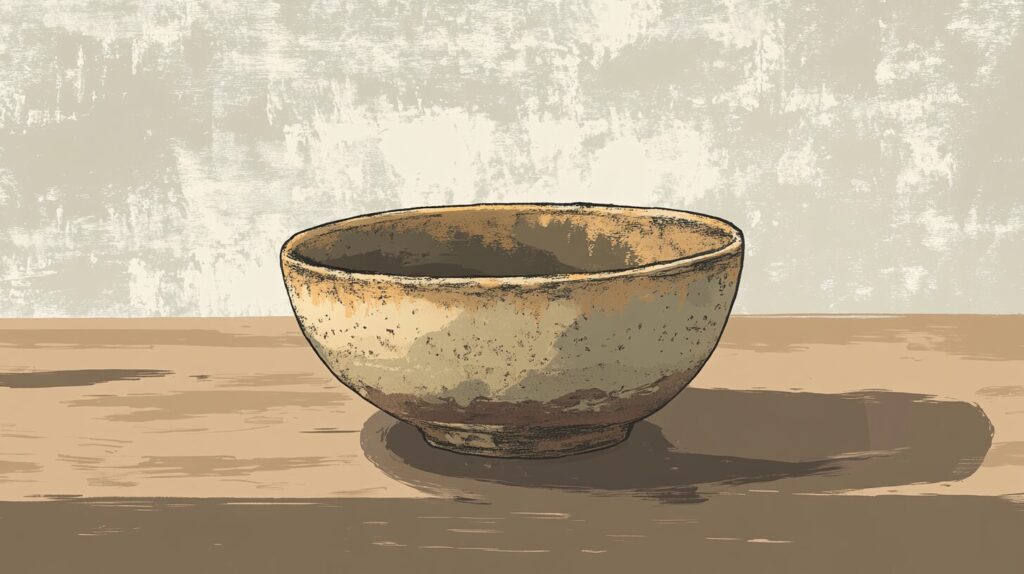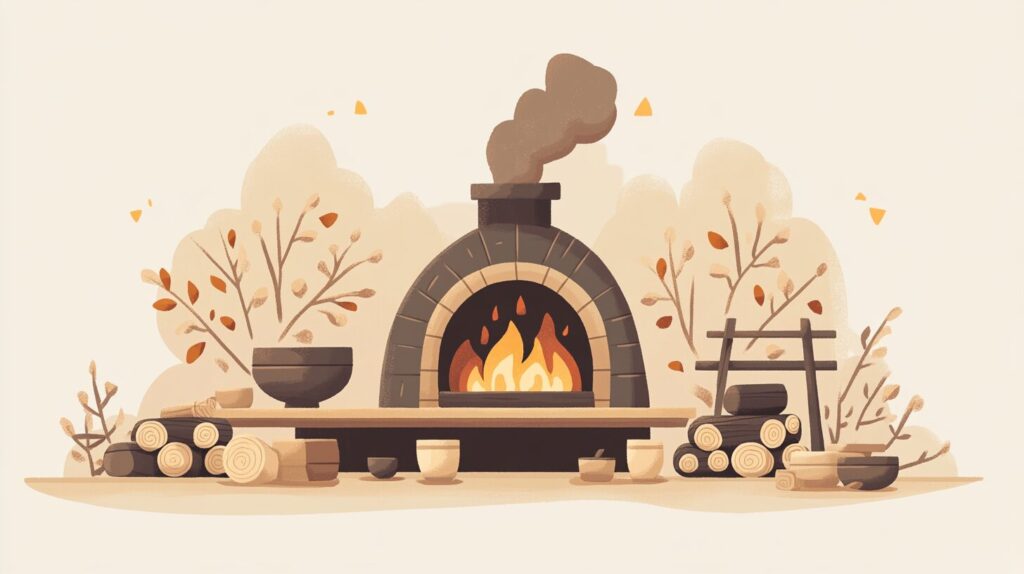信楽焼を英語で説明・紹介するための基本情報と、英会話に役立つ表現をシンプルでわかりやすい英語で紹介します。
英会話ダイアローグ・関連情報・10の質問を通して、信楽焼に関する英語表現を学びます。
英語
英会話ダイアローグを読む前に知っておくと良い前提知識と情報です。
- 信楽焼の基本情報
- 信楽焼の歴史: 約1300年前に誕生、「六古窯」の一つ(日本で最も古い歴史を持つ6つの窯業地)
- 場所: 滋賀県信楽町が発祥地、タヌキの置物:が全国的に有名
- 信楽焼の特徴
- 地元の粘土に長石が含まれており、粗い砂のような質感が特徴
- 焼成時に薪の灰が自然に作品にかかり、独特の模様や光沢が生まれる
- シンプルで不完全な美を重視する「わびさび」の概念と深く結びついている
- 信楽焼の魅力と進化
- 各作品は焼成中の自然の力で異なる模様ができ、同じものは一つとしてない
- 伝統を守りつつ、新しいデザインも取り入れられている
2 人が信楽焼について話しています。
信楽焼の歴史や特徴、タヌキの置物、茶器としての価値、「わびさび」との関連性などを話題にしています。
会話 / dialogue

Hey Key, I’ve been really interested in Shigaraki ware lately. Have you heard of it?

Yeah, I know a little about it. It’s one of the famous types of Japanese pottery, right? What got you interested?

I saw some beautiful Shigaraki tanuki statues at a shop the other day, and it made me curious. I heard they bring good luck.

That’s true! Those tanuki statues are iconic. They’re believed to bring prosperity, and you can see them all over Japan. But Shigaraki ware is much more than just tanuki.

Exactly. I’ve been reading up on it, and I found out it has a history of over 1,300 years! It started in the Nara period. Can you believe that?

That’s impressive. The fact that they’ve been making pottery for that long shows how strong the tradition is. Do you know why it’s so unique?

It’s the way it’s made. They use local clay that has feldspar in it, which gives it that rough, almost sandy texture. During the firing process, wood ash naturally falls onto the pieces, creating unpredictable patterns and natural glazes.

Oh, right. That’s what gives Shigaraki ware its rustic look. Each piece ends up being completely unique because of that process. It really fits with the Japanese wabi-sabi idea—finding beauty in imperfection.

Yeah, I love that concept. It feels like each piece has its own story, shaped by nature. I’m also curious about how it’s evolved over time. It seems like it started with making practical items like storage jars, but now it’s used for art pieces too.

That’s right. In the beginning, Shigaraki ware was mostly for everyday use—jars, pots, and so on. But over time, it became more artistic, especially during the tea ceremony period, when they started making tea bowls and vases.

That’s another thing that fascinates me. Even though it’s a centuries-old tradition, Shigaraki ware has adapted to modern tastes. There are new designs now, but they still respect the old techniques.

Exactly. They manage to blend tradition with innovation. That’s probably why it’s so popular, not just in Japan but also internationally. Have you ever thought about visiting Shigaraki to see how it’s made?

I’d love to! I think seeing the process up close would really deepen my appreciation for it. I read that they still use wood-fired kilns, which must be an amazing sight. Plus, I’d like to learn more about the firing process and how they control the ash patterns.

That would be an incredible experience. Shigaraki’s pottery studios are known for preserving those traditional methods. You could even try making your own piece.

That sounds like fun! It’d be cool to see how the clay changes during firing and maybe even take home something I made myself. Do you think they also teach about the history when you visit?

Definitely. I’ve heard that many of the workshops and museums there explain the history, from the early days to its modern evolution. They’ll probably tell you how Shigaraki ware became famous for its connection to wabi-sabi and how the natural elements play such a big role in shaping the pieces.

I’m really starting to appreciate the thought and effort that goes into each piece. It’s not just pottery—it’s art with deep meaning. And the fact that each piece is unique makes it even more special.

Yeah, that’s what makes Shigaraki ware so captivating. It’s like you’re holding a piece of history and nature combined. So, what’s your next step? Are you planning to start a collection?

Maybe! I’ve already got my eye on a couple of pieces, especially a tea bowl. I think owning one would be a great way to connect with Japanese culture and craftsmanship.

Sounds like a perfect idea. Once you start, it might be hard to stop collecting though! Each piece is so different.

I wouldn’t mind that! Plus, every time I look at a new piece, I feel like I’m learning more about Japanese culture and its appreciation for natural beauty.

That’s what’s amazing about Shigaraki ware—it connects you to both the past and the present. Let me know when you’re ready to go to Shigaraki. I’d love to join you!

I’ll definitely let you know. I think seeing the process firsthand would be a great experience. Thanks for all the info, Key!

Anytime! I’m sure you’ll appreciate Shigaraki ware even more after seeing it in person.
関連情報 / related information
「信楽焼」について、理解を深めるための「英語での関連情報」です。
信楽焼

History of Shigaraki Ware
Shigaraki ware is a traditional Japanese pottery that started over 1,300 years ago in the Nara period. It comes from the Shigaraki area in Shiga Prefecture. In the beginning, it was mainly used to make large storage jars and pots. Over time, Shigaraki ware became more artistic, especially during the tea ceremony period, when tea bowls and vases were popular.
Unique Features
Shigaraki ware is known for its rough, natural texture. This is because the clay contains feldspar, which gives it a sandy feel. During the firing process, wood ash falls onto the pottery, creating unique patterns and natural glazes. Each piece is different, making Shigaraki ware special and unique.
Wabi-Sabi Aesthetic
Shigaraki ware reflects the Japanese aesthetic of wabi-sabi, which values simplicity and finding beauty in imperfection. The rough texture and natural patterns are part of this concept. Over time, the pottery becomes more beautiful as it ages, showing its connection to nature.
Popularity
Shigaraki ware is famous for its tanuki (raccoon dog) statues, which are believed to bring good luck. These statues and other Shigaraki products are loved in Japan and internationally. Today, Shigaraki ware is both a practical item and a piece of art, blending tradition and modern design.
10の質問 / 10 questions
「信楽焼」について、理解を深めるための「英語での10の質問」です。
1: What is Shigaraki ware?
Shigaraki ware is a traditional Japanese pottery from Shiga Prefecture, known for its rough texture and natural appearance, often used in tea bowls, vases, and tanuki statues.
2: How long has Shigaraki ware been made?
Shigaraki ware has been made for over 1,300 years, starting during the Nara period in Japan.
3: What makes Shigaraki ware unique?
Shigaraki ware is unique because it uses local clay with feldspar, giving it a rough, sandy texture. The firing process also creates natural ash glazes and unpredictable patterns.
4: What is the wabi-sabi concept related to Shigaraki ware?
Wabi-sabi is a Japanese aesthetic that values simplicity and imperfection. Shigaraki ware reflects this concept with its natural, rustic beauty and unique imperfections.
5: What are Shigaraki tanuki statues?
Shigaraki tanuki statues are ceramic figures of raccoon dogs believed to bring good luck and prosperity. They are one of the most famous Shigaraki products.
6: What types of items are made from Shigaraki ware?
Shigaraki ware is used to make practical items like tea bowls, jars, and vases, as well as decorative items like tanuki statues.
7: How is Shigaraki ware fired?
Shigaraki ware is fired in wood kilns, and during the process, ash falls onto the pottery, creating natural glazes and unique patterns on each piece.
8: How has Shigaraki ware evolved over time?
Shigaraki ware started as practical pottery for storage but later evolved into more artistic pieces, especially during the tea ceremony period.
9: Is Shigaraki ware popular outside Japan?
Yes, Shigaraki ware is popular internationally, appreciated for its blend of traditional craftsmanship and modern design.
10: Can you visit Shigaraki to see the pottery process?
Yes, you can visit pottery studios in Shigaraki to see traditional techniques in action, and some studios even offer the chance to make your own piece.

和訳付
会話 / dialogue

Hey Key, I’ve been really interested in Shigaraki ware lately. Have you heard of it?
やあキー、最近信楽焼にすごく興味があるんだけど、知ってる?

Yeah, I know a little about it. It’s one of the famous types of Japanese pottery, right? What got you interested?
うん、少し知ってるよ。有名な日本の陶器のひとつだよね?どうして興味を持ったの?

I saw some beautiful Shigaraki tanuki statues at a shop the other day, and it made me curious. I heard they bring good luck.
この前お店で信楽焼のきれいなタヌキの置物を見て、気になったんだ。幸運をもたらすって聞いたよ。

That’s true! Those tanuki statues are iconic. They’re believed to bring prosperity, and you can see them all over Japan. But Shigaraki ware is much more than just tanuki.
それは本当だよ!タヌキの置物は象徴的だし、繁栄をもたらすって言われてるし、日本中で見かけるよね。でも、信楽焼はタヌキだけじゃないんだよ。

Exactly. I’ve been reading up on it, and I found out it has a history of over 1,300 years! It started in the Nara period. Can you believe that?
そうだよね。調べてみたら、1300年以上の歴史があるって分かったんだよ!奈良時代に始まったんだって。信じられる?

That’s impressive. The fact that they’ve been making pottery for that long shows how strong the tradition is. Do you know why it’s so unique?
すごいね。そんなに長く陶器を作ってるってことは、伝統がしっかりしてる証拠だよね。どうしてそんなに独特だか知ってる?

It’s the way it’s made. They use local clay that has feldspar in it, which gives it that rough, almost sandy texture. During the firing process, wood ash naturally falls onto the pieces, creating unpredictable patterns and natural glazes.
作り方が独特なんだよ。地元の粘土に長石が含まれていて、そのざらざらした砂みたいな質感が出るんだ。焼成中に薪の灰が自然に落ちて、予測できない模様や自然な釉薬ができるんだって。

Oh, right. That’s what gives Shigaraki ware its rustic look. Each piece ends up being completely unique because of that process. It really fits with the Japanese wabi-sabi idea—finding beauty in imperfection.
そうだね。それが信楽焼の素朴な外観を作ってるんだね。そのプロセスのおかげで、どの作品も唯一無二になるんだ。それって日本の「わびさび」の考えにぴったりだよね、不完全さの中に美を見出すって。

Yeah, I love that concept. It feels like each piece has its own story, shaped by nature. I’m also curious about how it’s evolved over time. It seems like it started with making practical items like storage jars, but now it’s used for art pieces too.
そうそう、その考え方が好きなんだ。自然が形作ったそれぞれの作品に独自の物語がある感じがする。それに、どうやって発展してきたのかも気になる。最初は貯蔵用の壺とか実用品を作ってたみたいだけど、今はアート作品にも使われてるよね。

That’s right. In the beginning, Shigaraki ware was mostly for everyday use—jars, pots, and so on. But over time, it became more artistic, especially during the tea ceremony period, when they started making tea bowls and vases.
その通りだよ。最初は主に日常的なもの、壺や鍋とかを作ってたんだ。でも時間が経つにつれて、特に茶道が発展した時期には、茶碗や花瓶みたいな芸術的なものを作るようになったんだよ。

That’s another thing that fascinates me. Even though it’s a centuries-old tradition, Shigaraki ware has adapted to modern tastes. There are new designs now, but they still respect the old techniques.
それもまた魅力だよね。何世紀も続く伝統がありながら、現代の好みにも合わせて進化してるんだ。新しいデザインもあるけど、昔の技法を大切にしてるのがいいよね。

Exactly. They manage to blend tradition with innovation. That’s probably why it’s so popular, not just in Japan but also internationally. Have you ever thought about visiting Shigaraki to see how it’s made?
まさにその通り。伝統と革新をうまく融合させてるんだよね。だから、日本だけじゃなくて海外でも人気があるんだと思うよ。信楽に行って、実際に作ってるところを見てみたいと思ったことある?

I’d love to! I think seeing the process up close would really deepen my appreciation for it. I read that they still use wood-fired kilns, which must be an amazing sight. Plus, I’d like to learn more about the firing process and how they control the ash patterns.
ぜひ行ってみたいよ!作ってるところを間近で見たら、もっと信楽焼を深く理解できると思うんだ。今でも薪を使った窯で焼いてるって読んだんだけど、それってすごい光景だろうね。それに、焼成の過程や灰の模様をどうやってコントロールしてるのかもっと知りたいな。

That would be an incredible experience. Shigaraki’s pottery studios are known for preserving those traditional methods. You could even try making your own piece.
それは素晴らしい体験になるね。信楽の陶芸スタジオは、そういった伝統的な方法を守ってることで有名だよ。自分で作品を作ってみることもできるよ。

That sounds like fun! It’d be cool to see how the clay changes during firing and maybe even take home something I made myself. Do you think they also teach about the history when you visit?
それは楽しそうだ!粘土が焼成中にどう変わっていくのか見られるのもいいし、自分で作ったものを持ち帰るのも面白そう。訪問したときに歴史についても教えてくれると思う?

Definitely. I’ve heard that many of the workshops and museums there explain the history, from the early days to its modern evolution. They’ll probably tell you how Shigaraki ware became famous for its connection to wabi-sabi and how the natural elements play such a big role in shaping the pieces.
間違いないよ。多くの工房や博物館では、初期の頃から現代までの進化について説明してるって聞いたよ。信楽焼がどうやって「わびさび」と結びついて有名になったのかや、自然の要素がどれだけ作品に影響を与えるかを教えてくれるはずだよ。

I’m really starting to appreciate the thought and effort that goes into each piece. It’s not just pottery—it’s art with deep meaning. And the fact that each piece is unique makes it even more special.
作品一つ一つに込められた考えや努力を本当に尊敬するようになってきたよ。ただの陶器じゃなくて、深い意味を持ったアートなんだよね。それに、どの作品も唯一無二っていうのがさらに特別だよね。

Yeah, that’s what makes Shigaraki ware so captivating. It’s like you’re holding a piece of history and nature combined. So, what’s your next step? Are you planning to start a collection?
そうだね、それが信楽焼の魅力だよね。歴史と自然が融合したものを手にしてるみたいな感じがするよ。じゃあ、次はどうするの?コレクションを始めるつもり?

Maybe! I’ve already got my eye on a couple of pieces, especially a tea bowl. I think owning one would be a great way to connect with Japanese culture and craftsmanship.
もしかしたらね!実はもういくつか気になってる作品があるんだ。特に茶碗がいいなって思ってる。ひとつ持ってると、日本の文化と職人技に触れられる気がするんだ。

Sounds like a perfect idea. Once you start, it might be hard to stop collecting though! Each piece is so different.
それはいい考えだね。でも、一度始めたら止まらなくなるかもよ!どの作品も全然違うから。

I wouldn’t mind that! Plus, every time I look at a new piece, I feel like I’m learning more about Japanese culture and its appreciation for natural beauty.
それはそれでいいかもね!それに、新しい作品を見るたびに、日本の文化や自然の美しさに対する感覚が深まる感じがするんだ。

That’s what’s amazing about Shigaraki ware—it connects you to both the past and the present. Let me know when you’re ready to go to Shigaraki. I’d love to join you!
それが信楽焼の素晴らしいところだよね。過去と現在の両方に繋がる感じがするんだ。信楽に行く準備ができたら教えてよ。僕も一緒に行きたいな!

I’ll definitely let you know. I think seeing the process firsthand would be a great experience. Thanks for all the info, Key!
もちろん教えるよ。実際に見てみると、すごい体験になると思う。色々教えてくれてありがとう、キー!

Anytime! I’m sure you’ll appreciate Shigaraki ware even more after seeing it in person.
いつでもどういたしまして!実際に見たら、信楽焼をもっと好きになると思うよ。
関連情報 / related information
信楽焼

History of Shigaraki Ware
Shigaraki ware is a traditional Japanese pottery that started over 1,300 years ago in the Nara period. It comes from the Shigaraki area in Shiga Prefecture. In the beginning, it was mainly used to make large storage jars and pots. Over time, Shigaraki ware became more artistic, especially during the tea ceremony period, when tea bowls and vases were popular.
信楽焼は1300年以上前、奈良時代に始まった日本の伝統的な陶器です。滋賀県の信楽地方で生まれました。当初は大きな貯蔵用の壺や鍋を作るために使われていましたが、時代が進むにつれて、特に茶道の発展により、茶碗や花瓶などの芸術的な作品が作られるようになりました。
Unique Features
Shigaraki ware is known for its rough, natural texture. This is because the clay contains feldspar, which gives it a sandy feel. During the firing process, wood ash falls onto the pottery, creating unique patterns and natural glazes. Each piece is different, making Shigaraki ware special and unique.
信楽焼は、そのざらざらした自然な質感で知られています。これは、粘土に長石が含まれているため、砂のような手触りを生み出します。焼成過程では、薪の灰が陶器に降りかかり、独特な模様や自然な釉薬ができます。それぞれの作品が異なり、信楽焼を特別で唯一無二のものにしています。
Wabi-Sabi Aesthetic
Shigaraki ware reflects the Japanese aesthetic of wabi-sabi, which values simplicity and finding beauty in imperfection. The rough texture and natural patterns are part of this concept. Over time, the pottery becomes more beautiful as it ages, showing its connection to nature.
信楽焼は、日本の「わびさび」の美学を反映しています。「わびさび」は、シンプルさや不完全さの中に美を見出すことを大切にします。粗い質感や自然な模様は、この概念の一部です。信楽焼は時間が経つにつれて美しさを増し、自然との繋がりを感じさせます。
Popularity
Shigaraki ware is famous for its tanuki (raccoon dog) statues, which are believed to bring good luck. These statues and other Shigaraki products are loved in Japan and internationally. Today, Shigaraki ware is both a practical item and a piece of art, blending tradition and modern design.
信楽焼は、幸運をもたらすとされるタヌキの置物で有名です。これらの像や他の信楽焼製品は、日本だけでなく海外でも愛されています。今日では、信楽焼は実用的な道具としても芸術作品としても評価され、伝統と現代のデザインが融合しています。
10の質問 / 10 questions
1: What is Shigaraki ware?
信楽焼とは何ですか?
Shigaraki ware is a traditional Japanese pottery from Shiga Prefecture, known for its rough texture and natural appearance, often used in tea bowls, vases, and tanuki statues.
信楽焼は滋賀県発祥の日本の伝統的な陶器で、ざらざらした質感と自然な外観で知られ、茶碗や花瓶、タヌキの置物によく使われます。
2: How long has Shigaraki ware been made?
信楽焼はどのくらいの歴史がありますか?
Shigaraki ware has been made for over 1,300 years, starting during the Nara period in Japan.
信楽焼は奈良時代に始まり、1300年以上にわたって作られています。
3: What makes Shigaraki ware unique?
信楽焼の特徴は何ですか?
Shigaraki ware is unique because it uses local clay with feldspar, giving it a rough, sandy texture. The firing process also creates natural ash glazes and unpredictable patterns.
信楽焼は、地元の粘土に含まれる長石がざらざらとした砂のような質感を生み出す点で独特です。焼成過程で自然に灰釉や予測できない模様が作られます。
4: What is the wabi-sabi concept related to Shigaraki ware?
信楽焼に関連する「わびさび」とは何ですか?
Wabi-sabi is a Japanese aesthetic that values simplicity and imperfection. Shigaraki ware reflects this concept with its natural, rustic beauty and unique imperfections.
わびさびはシンプルさや不完全さを尊ぶ日本の美学です。信楽焼は、その自然で素朴な美しさと独特の不完全さでこの概念を反映しています。
5: What are Shigaraki tanuki statues?
信楽焼のタヌキの置物とは何ですか?
Shigaraki tanuki statues are ceramic figures of raccoon dogs believed to bring good luck and prosperity. They are one of the most famous Shigaraki products.
信楽焼のタヌキの置物は、幸運や繁栄をもたらすとされるタヌキの陶器の像で、信楽焼の最も有名な製品の一つです。
6: What types of items are made from Shigaraki ware?
信楽焼ではどのような製品が作られていますか?
Shigaraki ware is used to make practical items like tea bowls, jars, and vases, as well as decorative items like tanuki statues.
信楽焼は、茶碗や壺、花瓶などの実用品から、タヌキの置物のような装飾品まで作られています。
7: How is Shigaraki ware fired?
信楽焼はどのように焼かれますか?
Shigaraki ware is fired in wood kilns, and during the process, ash falls onto the pottery, creating natural glazes and unique patterns on each piece.
信楽焼は薪窯で焼かれ、その過程で灰が陶器に降りかかり、自然な釉薬と独特の模様が作品に生まれます。
8: How has Shigaraki ware evolved over time?
信楽焼はどのように進化してきましたか?
Shigaraki ware started as practical pottery for storage but later evolved into more artistic pieces, especially during the tea ceremony period.
信楽焼は、最初は貯蔵用の実用的な陶器でしたが、後に芸術的な作品に進化し、特に茶道の時期に発展しました。
9: Is Shigaraki ware popular outside Japan?
信楽焼は日本以外でも人気がありますか?
Yes, Shigaraki ware is popular internationally, appreciated for its blend of traditional craftsmanship and modern design.
はい、信楽焼は伝統的な職人技と現代のデザインが融合した点で、海外でも人気があります。
10: Can you visit Shigaraki to see the pottery process?
信楽で陶器作りの過程を見ることができますか?
Yes, you can visit pottery studios in Shigaraki to see traditional techniques in action, and some studios even offer the chance to make your own piece.
はい、信楽の陶芸スタジオでは、伝統的な技法を見ることができ、一部のスタジオでは自分で作品を作る体験も提供しています。

words & phrases
英会話ダイアローグと関連情報に出てきた単語・フレーズです(例文は各3つ)。

ware : 名詞
意味: 商品、製品、特に陶磁器やガラス製品など。Items made from a particular material or used for a specific purpose, often related to pottery or glass.
(信楽焼のような陶器を指す際に使用)
例文:
- The store sells different types of ceramic ware.
「その店ではさまざまな種類の陶器を販売しています。」 - Japanese tea ware is known for its elegance.
「日本の茶器はその優美さで知られています。」 - Shigaraki ware is famous for its natural appearance.
「信楽焼はその自然な外観で有名です。」
pottery : 名詞
意味: 陶器類、陶芸。Objects made from clay and hardened by heat; the art or process of making these objects.
(信楽焼などの陶器全般を指す)
例文:
- She enjoys making pottery in her free time.
「彼女は暇なときに陶器作りを楽しんでいます。」 - The museum has an extensive collection of ancient pottery.
「その博物館には古代の陶器の大規模なコレクションがあります。」 - Pottery from Shigaraki is known for its rough texture.
「信楽の陶器はそのざらざらした質感で知られています。」
glaze : 名詞
意味: 釉薬。陶器にかける光沢を出すためのコーティング。A liquid that is applied to pottery before firing to give it a shiny or matte finish.
(信楽焼の釉薬によってできる自然な光沢を指す)
例文:
- The pot was covered with a beautiful blue glaze.
「その壺は美しい青い釉薬で覆われていました。」 - The artist applied a clear glaze to the pottery.
「その芸術家は陶器に透明な釉薬をかけました。」 - The glaze gave the vase a shiny finish.
「釉薬がその花瓶に光沢のある仕上がりを与えました。」
rustic : 形容詞
意味: 素朴な、田舎風の。Simple, natural, and often rough in appearance, resembling the countryside.
(信楽焼の素朴な外観を表現するために使用)
例文:
- The restaurant has a rustic charm with its wooden tables and stone walls.
「そのレストランは木のテーブルや石の壁があり、素朴な魅力があります。」 - The rustic design of Shigaraki ware is part of its appeal.
「信楽焼の素朴なデザインは、その魅力の一部です。」 - We stayed in a rustic cabin in the mountains.
「私たちは山の素朴なキャビンに泊まりました。」
kiln : 名詞
意味: 窯、特に陶器を焼くためのもの。A large oven used for firing pottery, bricks, or other materials.
(信楽焼が焼成される薪窯を指す際に使用)
例文:
- The potter placed the clay pots in the kiln to be fired.
「陶芸家は粘土の壺を焼成するために窯に入れました。」 - The kiln was fired up for a full day to finish the pottery.
「その窯は陶器を完成させるために一日中稼働しました。」 - Shigaraki ware is known for its use of wood-fired kilns.
「信楽焼は薪窯で焼かれることで知られています。」
